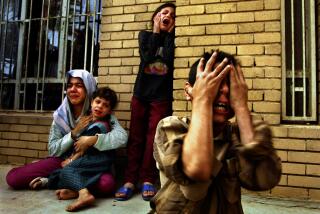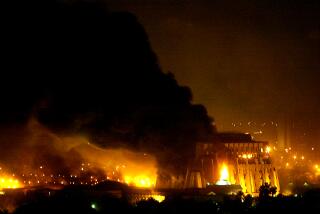Iraqis Use Fakery to Confuse Pilots : Tactics: Cars and bridges are camouflaged. Smoky fires are set to make fliers think Baghdad is burning.
BAGHDAD, Iraq — Some car owners here have taken to smearing their vehicles with mud paste to disguise them in an effort to protect them from the allied air bombardment.
Iraqi militia forces and civilians also have been collecting bags made of jute, which are wrapped around the iron railings of the bridges over the Tigris River, then dotted with small tree branches and green leaves in an attempt to camouflage the bridges from air attack.
“We know the jute bags and the tree branches may not save the bridges, but at least we are trying to save our city with whatever we have,” an Iraqi civil defense official explained.
Four weeks of intense allied bombing have had an impact on Baghdad’s residents, who are less likely now to joke about the U.S. Army or the threat of destruction.
But, based on an eight-day assignment in Baghdad, there is no visible sign of panic in the sprawling city of 4 million.
Residents disregard the air raid sirens, and even the raids themselves, to go about their business.
The war-hardened Iraqis employ many low-technology methods to try to offset the superior military might of the U.S.-led forces.
In addition to camouflaging cars and bridges, the Iraqis every day scour Baghdad for tires, old clothes, scraps of plastic and any other flammable refuse.
This material is set ablaze around the city--for example, under bridges over the Tigris that connect the western and eastern districts of Baghdad. The spewing smoke, which gets so thick sometimes that the sun is blotted out, is designed to shield the Iraqi capital from further aerial attack by giving a false impression to allied surveillance satellites that parts of Baghdad are burning.
The defensive campaign is spearheaded by members of President Saddam Hussein’s militia, the Popular Army. The militia is Hussein’s second line of defense, trained in civil defense and hand-to-hand combat, in case the war over Kuwait reaches Baghdad one day.
“We may not be Rambos, and we may not have ‘Star Wars’ capabilities, but we know how to defend ourselves,” said one Popular Army militiaman who did not give his name.
Most ordinary Iraqis appear to have accepted that their lives depend on fate, not on hiding in bomb shelters.
In Baghdad alone, at least 200 targets have been hit during the air offensive.
In the first two weeks, military targets and communication centers were hit. More recently, the raids have destroyed government and private buildings across the city.
Twelve bridges, including six in the central part of the city, connect the two sectors; four of the bridges have been destroyed by allied bombs.
One of the latest targets was a $16-million conference center near the Rashid Hotel, home to many foreigners.
The allied aerial attacks have produced a tremendous anger, directed at the United States, and a growing feeling that Hussein should not have invaded Kuwait in the first place, although the outrage does not seem to have reached the levels reported 110 miles away in Diwaniyeh.
There, travelers leaving the area have said that as many as 5,000 people took part in a demonstration in which protesters angry about Hussein’s refusal to relinquish Kuwait killed 10 members of the country’s ruling party.
In Baghdad, an employee at the Rashid, who did not want to give his name, also objected to government policies, saying: “We Iraqis were slowly returning to normal life after our war with Iran (from 1980-88). There was no need to invade Kuwait. We don’t need the oil. We need to live.”
This story was written in Jordan and was not subject to Iraqi censorship.
More to Read
Sign up for Essential California
The most important California stories and recommendations in your inbox every morning.
You may occasionally receive promotional content from the Los Angeles Times.










